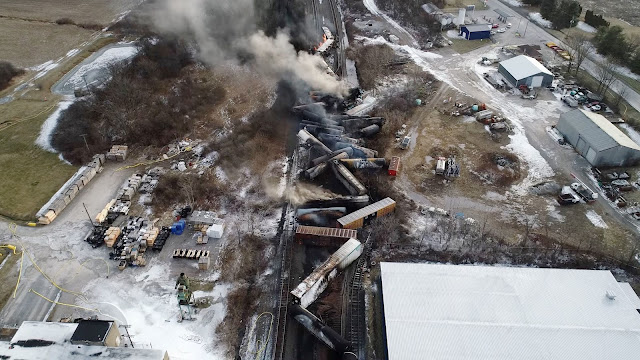Residents of Ohio are outraged following a recent train derailment that resulted in toxic chemicals being released into the environment. The incident has led to a series of confrontations between residents and the CEO of the train company responsible for the accident.
Here is a breakdown of what happened, the aftermath, and the town hall meeting that took place between residents and the CEO.
The derailment
On the night of February 6th, a train carrying hazardous materials derailed in the small town of Oakwood, Ohio. The train was carrying more than 100 cars of mixed freight, including chemicals such as styrene, which can be highly flammable and toxic if inhaled.
Residents in the surrounding area were immediately evacuated, and the town declared a state of emergency. The derailment caused the closure of a nearby highway and forced several businesses to shut down.
The aftermath
In the aftermath of the derailment, residents were outraged at the lack of transparency from the train company responsible for the accident, Norfolk Southern. They expressed concerns about the potential health risks associated with the hazardous chemicals released into the environment.
Norfolk Southern initially released a statement expressing concern for the community's safety and pledging to take swift action to clean up the site. However, residents claimed that the company did not provide enough information about the severity of the accident and the potential risks to public health.
The town hall meeting
As tensions rose in the aftermath of the derailment, CNN hosted a town hall meeting between residents and the CEO of Norfolk Southern, James Squires. The meeting provided an opportunity for residents to confront Squires and demand answers about the accident and the company's response.
Residents expressed anger and frustration at what they perceived as a lack of accountability and transparency from Norfolk Southern. Many questioned the company's safety protocols and its commitment to protecting the community.
Squires apologized to the community for the accident and pledged to take responsibility for the cleanup effort. He also promised to review the company's safety protocols and make necessary changes to prevent similar accidents from occurring in the future.
Residents remained skeptical, however, and demanded greater transparency and accountability from the company moving forward. They expressed concern about the long-term effects of the accident on the environment and their health.
Moving forward
The train derailment in Oakwood, Ohio, serves as a reminder of the potential risks associated with hazardous materials transportation. It also highlights the importance of transparency and accountability in the aftermath of such accidents.
Residents have a right to know the potential risks associated with hazardous materials in their communities and to demand accountability from the companies responsible for their transportation. The town hall meeting between residents and the CEO of Norfolk Southern is a step in the right direction, but it remains to be seen whether the company will follow through on its promises to the community.
In the meantime, residents of Ohio and other communities across the country must remain vigilant in advocating for their safety and holding companies accountable for their actions.
Ohio resident: Everything is not fine
Ohio, one of the most populous states in the Midwest, is not immune to the issues and problems that plague the country as a whole. While it may not receive as much attention as some of the larger states, Ohioans are feeling the effects of national issues such as political division, income inequality, and systemic racism. As a resident of Ohio, I can confidently say that everything is not fine.
Political Division
One of the biggest issues facing Ohio, as well as the rest of the country, is political division. The country is split along party lines, and Ohio is no exception. With a Republican governor and a largely conservative legislature, Ohio is often seen as a red state. However, there are many areas of Ohio that are more liberal, such as Cleveland and Columbus. This has created a sharp divide between urban and rural areas, with each side feeling like the other does not understand their perspective.
Income Inequality
Another issue facing Ohio is income inequality. While Ohio has a lower cost of living than many other states, wages have not kept up with inflation. Many people in Ohio are working multiple jobs just to make ends meet. This is especially true in the rural areas of Ohio, where jobs are scarce and wages are low. Meanwhile, the wealth gap continues to widen, with the top 1% in Ohio owning more than the bottom 50%.
Systemic Racism
Like the rest of the country, Ohio has a long history of systemic racism. From redlining in cities like Cleveland and Cincinnati to unequal access to education and healthcare, Black and Brown Ohioans have been marginalized for decades. This has led to high rates of poverty and crime in many urban areas of the state. While there have been efforts to address these issues, such as the creation of the Ohio Minority Health Strike Force in 2020, there is still a long way to go.
Environmental Issues
Ohio is also facing a number of environmental issues, from toxic algae blooms in Lake Erie to air pollution in cities like Cleveland and Akron. These issues disproportionately affect low-income and minority communities, who are more likely to live near sources of pollution. Despite the severity of these issues, many in Ohio are still resistant to taking action to address them, citing concerns about jobs and the economy.
The Pandemic
Of course, no discussion of the issues facing Ohio would be complete without mentioning the pandemic. Like the rest of the country, Ohio has been hit hard by COVID-19. While the vaccine has brought hope, cases are still rising in many parts of the state, and there is a great deal of uncertainty about what the future holds. The pandemic has also highlighted existing inequalities in the state, such as unequal access to healthcare and paid sick leave.
Conclusion
In conclusion, as a resident of Ohio, I can say that everything is not fine. Ohio is facing many of the same issues as the rest of the country, from political division to income inequality to systemic racism. While there are certainly reasons to be hopeful, such as the recent election of a more progressive mayor in Columbus, there is still a great deal of work to be done to address these issues and build a more equitable future for all Ohioans.











